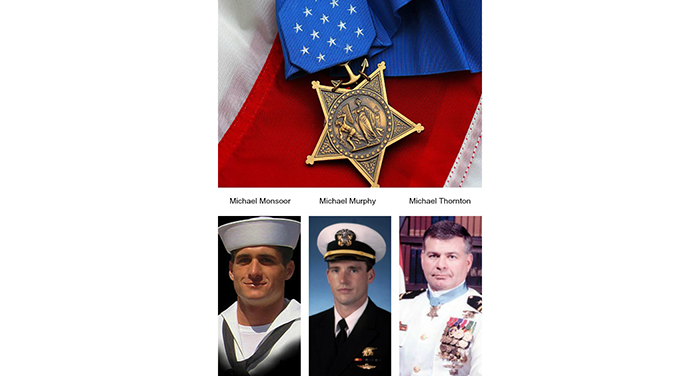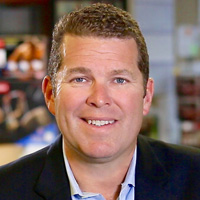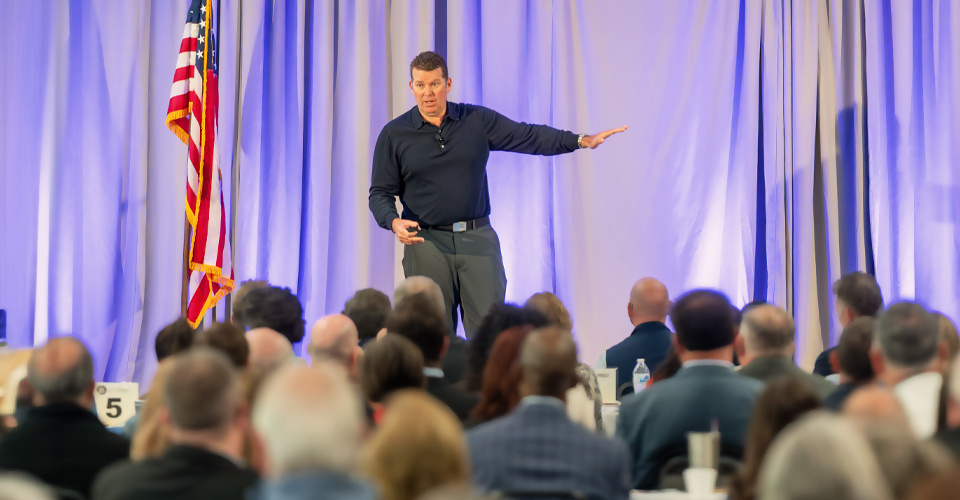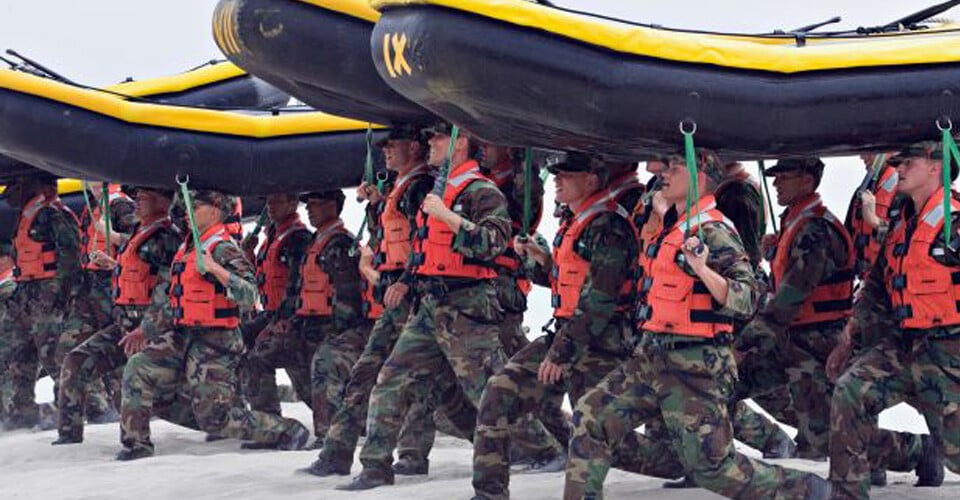On September 29, 2006 25-year-old Navy SEAL petty officer Michael Monsoor was on a patrol in Ar Ramadi, Iraq. His responsibility that day was to provide machine gun cover fire and support for three Navy SEAL snipers while also providing training to Iraqi Army soldiers. This particular day’s mission was to prevent the enemy from conducting an attack in a highly contested area of the city of Ramadi. The squad of four SEALs and three Iraqis took up a fighting position on top of a small building. The snipers went to work eliminating enemy targets who were positioning themselves for a counter-attack on the small SEAL/Iraqi team. While snipers engaged the enemy, Michael protected the snipers. He provided cover fire as well as guarding the only exit on the rooftop. During the gun battle, an unseen insurgent threw a grenade into their position that bounced off of Michael’s chest. Without hesitation, Michael jumped on the grenade. He lived for 30 minutes before paying the ultimate sacrifice. His actions saved the lives of his three teammates and the Iraqi soldiers.
What made Michael jump on the grenade? We don’t train to jump on grenades in SEAL Team. There is no “standard operating procedure” for placing your body over a live grenade. Why would Michael knowingly sacrifice his life when he could have saved it by jumping down the exit ladder? Michael Monsoor used his body for a shield for the same reasons another Michael nine months earlier did something similar.
On June 28, 2005, Lt Michael Murphy and three SEAL teammates were conducting a mission deep behind enemy lines in a mountain range of Afghanistan. The team’s position was comprised by local unarmed villagers. Lt. Murphy made the call to let the villagers go, knowing they would most likely alert nearby Taliban forces of his team’s presence. The SEALs’ mission quickly changed from “hunting” to being “hunted” by over 50 Taliban fighters. A two-hour gun battle ensued. The enemy flanked the four-man fire team on three sides and pushed them into a steep ravine that blocked their communication signals to reach help. The team’s only hope for survival was to alert their teammates who were at base on the other side of the mountain range. Running dangerously low on ammunition and with all of his teammates wounded, Michael chose to leave his protected location and expose himself to direct enemy fire. While transmitting his location to SEALs at the nearest base, Michael dropped the radio when he was shot in the back. He composed himself, calmly picked the transmitter up and continued to rely his situation to his awaiting teammates. After completing the radio transmission, Michael made it back to his three wounded teammates and continued the fight. His brothers from the nearby base mounted a helicopter rescue operation in broad daylight against an unknown enemy size and into some of the most unforgiving terrain in the world. The main helicopter carrying 16 special operation warriors was hit by a rocket propelled grenade near the battle scene of Michael’s team. All 16 men in the helicopter perished. Shortly thereafter, Michael and two of his teammates died, along with an estimated 35 Taliban enemy fighters. It was the single greatest loss of life for the Navy SEAL Teams since World War 2.
Like the first Michael, a similar question arises, what makes someone sacrifice their life for others? In SEAL Team, we don’t practice jumping on grenades nor do we practice running into the line of fire. So why did he do it? Because there was a third Michael – Michael Thornton, who thirty-three years earlier did exactly the same thing Michael Murphy did, except this time it was an enlisted man attempting to save the life of his platoon commander, Tom Norris.
On October 31, 1972, Petty Officer Michael Thornton, Lieutenant Tom Norris and five South Vietnamese special operators landed on the wrong beach in North Vietnam for what was supposed to be a reconnaissance mission. Shortly after swimming ashore, they were confronted with 50 heavily armed enemy troops. By accident, one of the South Vietnamese engaged the enemy, alerting them of the team’s presence. The small squad retreated quickly to the sea while under heavy enemy fire. As they started to swim out of the surf, Michael turned to ask one of his Asian teammates where the “boss” was, to which he replied in broken English, “he dead – shot in head – he somewhere on beach”. Michael refused to leave Tom behind, and returned to the beach to retrieve him. His “officer” was shot in head, unconscious, but alive. For the next two and half hours Michael swam his unconscious platoon leader out to sea for an eventual rescue. His actions saved the life of Tom Norris, who despite his wounds made a full recovery. More remarkable still, as they would both discover a few years later, Michael’s actions were historically unique for it was the first time a Medal of Honor recipient had saved the life of another Medal of Honor recipient. Tom Norris had unknowingly been up for the Medal of Honor for another mission he led months earlier.
All three Michaels received our Nation’s highest honor, the Medal of Honor. They are Navy SEAL heroes. Michael Monsoor and Michael Murphy’s actions of bravery and courage are immortalized with two state-of-the-art Guided Missile Destroyers with their names on them. So why did they do it? Why did they consciously give their lives so others could live?
I know their kind and I know why they did it, and I know there are many others like them who would have done the same thing. As a former Navy SEAL platoon commander, I had the honor of serving with lots of like-minded “Michaels”. They did not give their lives for recognition or monetary gain or the naming of a ship. They did it because they cared so deeply for their teammates and what their teammates stood for that the thought of letting them down was unthinkable. Their level of care approaches the same intensity of love that a father or mother has for their children. They did it because of the promise they made to each other; because their team is their family; because of what their team stands for. They willingly gave these sacrifices because they knew of others who had given similar sacrifices. They did it because breaking their promise to their teammates was a worse outcome than keeping their promise.
I share these three stories to demonstrate the ultimate in team sacrifice: giving your life so others may live. The point is not to pressure others into giving similar sacrifices but instead to show the power of what I call an Unstoppable Team. These three “Michaels” span more than 30 years of service and they all served in different SEAL platoons, yet all performed similar acts of uncommon valor. Though their circumstances were all different, their actions remained the same. Why? What’s the common thread? Sure, you can say the obvious: “They were all SEALs”. But beneath the bravado, the commando mentality, SEAL Team ethos is an exceptional amount of care we have each other. There’s a confidence that comes from this level of care that can be best explained as “I’ve got your back, brother.” That knowledge propels each teammate to never let the other one down – no matter what situation you’re in.
I’ve Got Your Back
I’ve had the privilege to build and lead several different types of teams that I would call Unstoppable Teams. From building and leading three SEAL platoons to creating America’s fastest growing consumer products company (in 2009) to leading a 150-person charity group to chairing a $30MM bond campaign for our local school, all of these teams, though different in direction, are all the same in principle – they were CARE-based teams, and they all shared a similar element – the philosophy of “I’ve got your back”.
These teams didn’t come from luck or good fortune. They were galvanized by purpose-driven actions (learned over years of making mistakes!) that built trust, direction, contribution and ownership. I’m not the best at memorizing things so I built a memory aid to help you (and me) always remember the actions required to build Unstoppable Teams.
The memory aid is CARE, and the letters stand for:
C – Connect
A – Achieve
R – Respect
E – Empower
Each “pillar” action, as I call them, is composed of several smaller actions that when done in concert will help you build an Unstoppable Team. The next series of blogs will discuss the “Why”, “How” and “What” of CARE-based Teams. There’s going to be a lot information coming at you, but don’t despair, you CAN do it and before you know it, you’ll be on your path to building Unstoppable Teams. I promise, over time it will come naturally, so long as you CARE enough to give it all you’ve got, because that’s what you’ll be asking your teammates to do as well!
All in, All the time – that’s what it takes.
Alden





